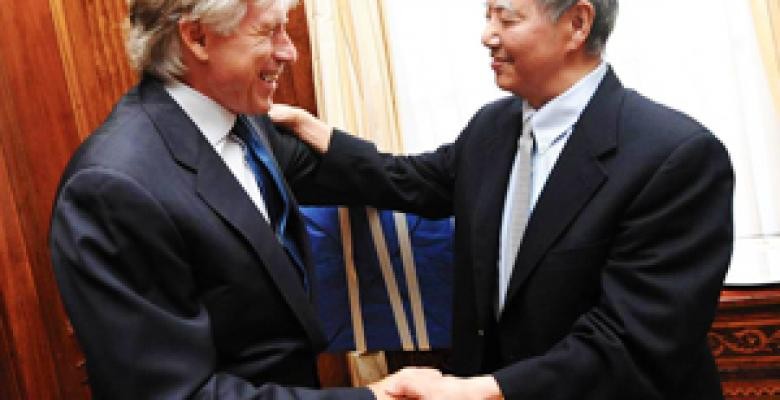"Pleasure Is Learning": University Honors Retiring Nobel Laureate T.D. Lee

When T.D. Lee was hired by Columbia as an assistant professor in 1953, he joined what was arguably one of the greatest physics departments ever assembled. And in short order, the 26-year-old theoretical physicist became a legend himself.
In 1956, Lee was named the University’s youngest full professor, and a year later, when he was barely 31, he won the Nobel Prize, becoming the second-youngest scientist ever to receive the honor.
Nearly six decades after joining Columbia, Lee is retiring as University Professor at the end of this year. At a reception in his honor at the President’s House on Sept. 13, Columbia President Lee Bollinger singled out Lee’s staggering scholarly contributions to the field of physics.
“T.D. Lee has succeeded into his 84th year in continuing to push the boundaries of the study of particle physics,” said Bollinger, “and in every important way his unsurpassed career represents all that is best about Columbia University and about the academy.”
The Chinese-born Lee earned his Ph.D. from the University of Chicago with a thesis titled Hydrogen Content of White Dwarf Stars. He was the doctoral student of another Columbia legend and Nobel laureate, Enrico Fermi, who, along with J. Robert Oppenheimer, is remembered as the father of the atomic bomb.
Indeed, it was Oppenheimer who hired Lee in 1951 as a fellow at the Institute for Advanced Study in Princeton, praising him as one of the most brilliant theoretical physicists of his time. Lee’s discoveries, he said, were characterized by “a remarkable freshness, versatility and style.”
The Columbia physics department that Lee joined in the mid-1950s was already the stuff of legend, with nearly a dozen faculty members who had already won Nobel Prizes or would go on to win one.
Surveying the major accomplishments in the field of physics, Lee said in an interview before the reception, “A very large portion was generated here.” About the next generation of Columbia physicists, he added, “I don’t know what they are going to do, but it will be great things, just like in the past.”
Lee’s own collected scientific papers total some 2,400 pages of research that has reshaped the understanding of the physical world. He has made significant contributions in the fields of astrophysics, statistical mechanics, field theory and turbulence, solving several problems of longstanding and great complexity. And his advances in particle physics are providing the underpinnings for new breakthroughs that will be made possible by the Large Hadron Collider particle accelerator near Geneva.
Said William Zajc, physics department chair, “It is impossible to overstate T.D.’s influence on the Department of Physics, on Columbia and on the entire field of physics.”
When Lee was asked to single out some of his career highlights at Columbia, he demurred. “It’s almost like, in the evening you look at the sky—is there one star that you particularly like?”
In addition to his teaching and research at Columbia, Lee worked throughout his career to promote scientific education in China, as well as international cooperation between China and the U.S. in the areas of education and research.
Yet despite a lifetime of awards and honors, including having a planet named after him, Lee hasn’t slowed down. At his reception, he distributed a 231-page booklet of some of his most recent research papers, all of them published since 2006. On the inside cover of the booklet was a quote from Confucius: “Pleasure is learning and being able to practice often-times what one has learned.”
Reflecting on his imminent retirement, Lee said, “It’s like gardening. You may not be cultivating a new species, but you can still keep the old beautiful thing going on.”